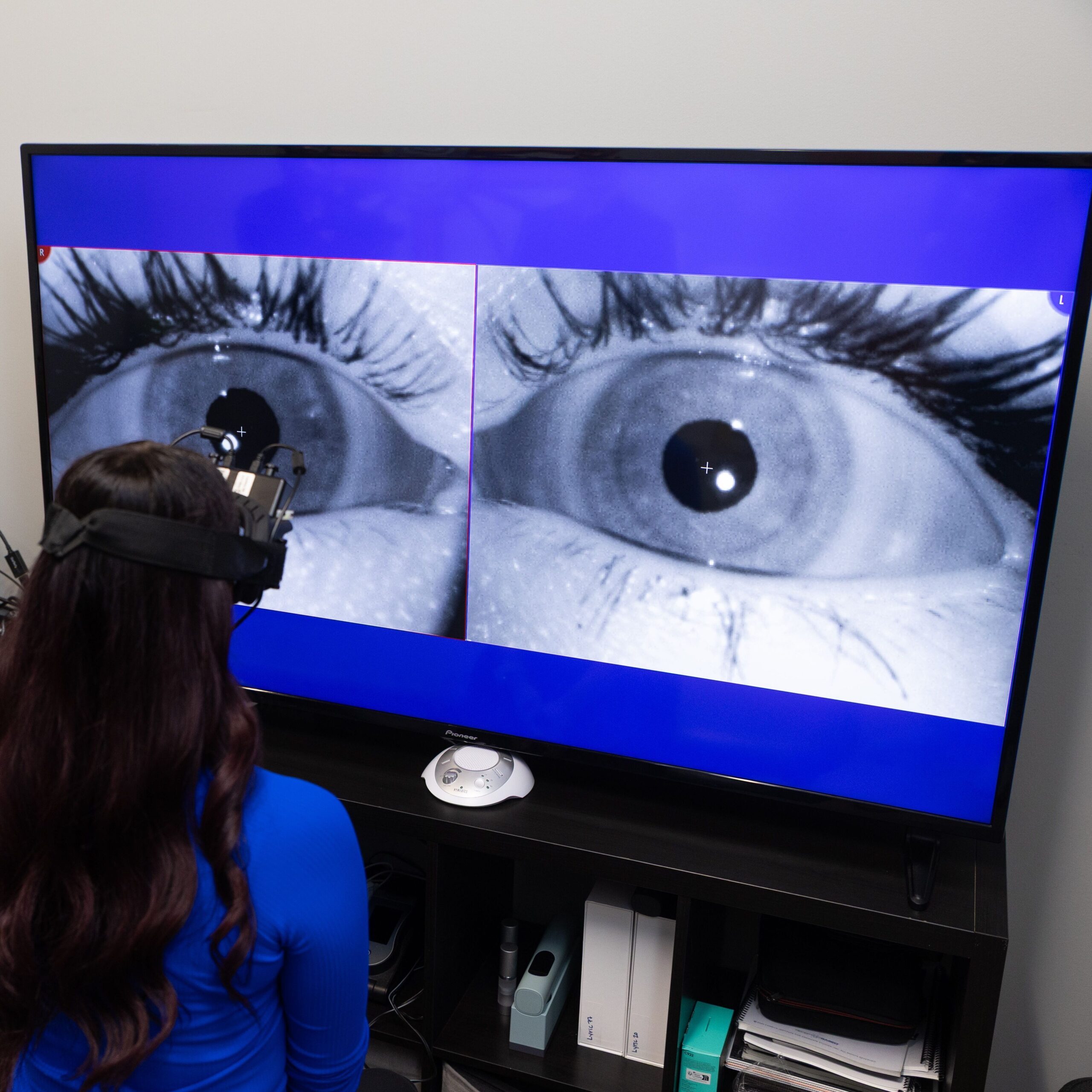Are you someone who experiences migraine pain in shoulders and neck? What if we told you this pain isn’t just caused by your migraine but rather a completely different presentation alongside your migraine?
Migraine and migraine-associated disorders are a specific type of neurological and vascular disorder affecting 1 in 5 women in the US. Migraines don’t just “happen in the head”—they can be accompanied by symptoms of radiating pain through your shoulders, neck, and upper spine.
Many patients visiting The Neural Connection report that their migraine attacks often begin with tension or stiffness in the neck and shoulders. Others experience lingering pain in these areas after the worst of the migraine has passed. If this pattern sounds familiar, you’re not alone.
There’s often a reason your migraine pain affects other areas of your head and body.
In this article, we’ll explore how migraine pain in the shoulders and neck occurs, why it’s more than just muscle tension, and what can be done to relieve it.
Why Migraine Pain Often Involves the Neck and Shoulders
Although migraines are a neurological condition, they involve the entire nervous system—including the muscles, joints, and tissues around your neck. Technically speaking, migraines are considered a neurovascular disorder, where both neurological and vascular issues cause symptoms.
When a migraine strikes, your brain becomes hypersensitive to signals from the environment and body. Anyone who has experienced an aura before a migraine can attest to this pattern.
During an attack, the brain will often fire stress-induced signals to the cervical spine and neck muscles, triggering or worsening overall migraine pain. Evidence also shows that people with migraines are more likely to have myofascial trigger points (tight muscle knots) in the neck and shoulders. Because of this, patients who struggle with migraine inherently require a multi-faceted approach to finding solutions.
These myofascial and neck areas can become overactive because of alterations in how the brain processes pain, tension, and movement. In many cases, the body enters a state of protective guarding, causing the neck and shoulder muscles to stiffen and spasm in response to the migraine and inflammation present.
Cervicogenic (Neck) Inputs – A Key Factor in Migraine Pain in Shoulders and Neck
Your upper neck contains specific peripheral nerve structures that directly feed into the trigeminocervical complex. This complex is a targeted region in the brainstem that processes pain in the head, face, and neck. Trauma from injuries to the head and neck, along with altered central processing, can skew neurological integration and cause migraine flares. And while treating the neck is often necessary, it’s not the only approach to finding solutions.
This connection explains why neck and shoulder pain often shows up before, during, or after a migraine episode—and why treating the brain alone isn’t always enough. It’s also a fundamental reason why medications may not always be effective in treating migraine attacks.

Are Your Symptoms From a Tension Headache or Migraine?
Many people confuse migraine pain in shoulders and neck with tension headaches, especially when the discomfort feels like tight bands wrapping around the skull or down the neck. We see it far too often at The Neural Connection, even after patients have seen headache specialists and neurologists.
But don’t be fooled–there are notable differences between these two conditions.
Tension headaches typically remain mild to moderate and don’t cause visual auras. For the most part, symptoms occur on both sides of the head and face, and don’t involve overt neurological symptoms, such as dizziness. Tension headaches are commonly located over the base of the skull and wrap around the forehead in a “band-like” pattern.
Migraines, on the other hand, often involve throbbing and stabbing pain on one side of the head. They’re frequently accompanied by light sensitivity, significant fatigue, and altered cognitive processing. In some migraine variants, patients will experience disturbances in speech, visual loss, and vertigo.
With that said, the overlap between these two types of conditions explains why neck and shoulder tension can both trigger and intensify migraines. This feedback loop can create a frustrating cycle that feels difficult to break.
If you’re still struggling with migraines or chronic headaches and have tried “everything,” don’t lose hope. Our highly specialized providers at The Neural Connection often assist patients in similar situations.
How We Treat Migraine Pain in Shoulders and Neck at The Neural Connection
At The Neural Connection, we specialize in functional neurology—a patient-centered approach that focuses on identifying and correcting the root cause of your symptoms. Because we understand the underlying neurophysiology of migraine and chronic headaches, we provide patients with personalized integrative approaches to healing.
When migraine pain affects the shoulders and neck, we start by evaluating the integrity of the cervical spine, posture, vestibular system, and neurological reflexes. Our goal is to understand whether your migraine symptoms stem from altered sensory integration, changes in muscle tone, prior concussions, or unresolved biomechanical imbalances.
Using non-invasive assessments and targeted therapies, we retrain the brain and body to function more effectively—ultimately reducing migraine frequency and neck-related pain.
Our goal is to help you update your brain’s neurological software to live your life to the fullest. Migraine pain in shoulders and neck should be a thing of the past.
Here’s how our personalized assessment and treatment process works:
1. Neurological Examination and Cervical Spine Testing
During your initial visit, we perform an in-depth neurological and structural examination to assess your overall function. During the visit, we assess joint mobility, head positioning, eye-tracking, and cervical reflexes to identify any underlying dysfunction.
This process helps us pinpoint the exact structural and neurological systems that may be causing your symptoms. It also helps us determine whether we need to consider addressing underlying metabolic factors.
2. Myofascial Release, Manual Therapies, and Neuromuscular Retraining
We often use hands-on techniques, therapeutic exercises, and neuromuscular retraining to alleviate tension in overworked muscles and activate underutilized stabilizers. Our personalized approach to therapy and treatment incorporates techniques from a range of fields of study.
We also employ a range of manual therapies, including manipulations, soft tissue techniques, and training tools, to enhance overall function. The goal of treatment is to see change as quickly as possible and support long-term improvements with at-home therapies. Treating the migraine pain in shoulders and neck is always part of that process.
Patients know we’re adamant about doing home exercises because the more they do at home, the less they have to see us in the office.

3. Vestibular and Visual Integration Therapies
When the brain is struggling to interpret signals from the neck, eyes, and balance systems, symptoms often occur. In these situations, we use custom-designed exercises to correct the mismatch, driving change and symptom improvement.
Improving how your brain integrates visual, vestibular, and proprioceptive input can significantly reduce symptoms associated with migraines. When migraine pain in the shoulders and neck occurs, therapies often reduce this neural “confusion” and can restore efficient movement patterns.
Due to our integrative approach, patients who have previously undergone visual or vestibular therapies can still experience benefits from treatment. By targeting all of these systems simultaneously, we can generate changes in the brain at a faster rate.
4. Nutritional and Metabolic Support
Sadly, we commonly find that patients who struggle with migraine symptoms often have unresolved gut and digestive issues. And when addressing these issues clinically, we’ve seen significant improvements in symptoms.
At The Neural Connection, we’re always assessing patients for nutrient deficiencies, inflammation, and food triggers that may be contributing to their symptoms. Many patients with migraine pain in the shoulders and neck benefit from these approaches because inflammation can present in different ways.
By taking a personalized approach to treatment, we can uncover root causes that traditional medical providers often overlook.
Home Strategies to Reduce Migraine-Related Neck and Shoulder Pain
While in-clinic treatment offers the most effective long-term relief, you can support your healing process at home with a few simple changes:
- Correct your posture throughout the day, especially while sitting or using screens, to improve ROM and function.
- Use a cervical pillow to maintain proper neck alignment while sleeping.
- Apply altering warm/cold compresses and perform light neck stretches when you feel early warning signs of migraine pain in shoulders and neck.
- Incorporate breathing exercises and mindfulness techniques to reduce stress-related muscle tension in the shoulders, neck, and face.
- Stay hydrated (with electrolytes) and track your nutrition, as dehydration and food triggers can heighten body inflammation and increase pain in the neck and head.
- Take frequent breaks to move your body and enhance blood flow to the brain.
- Prioritize getting 7-8 hours of sleep each night to optimize recovery and cellular healing.
Note that if these strategies only offer temporary relief, it’s time to consider a more comprehensive solution with trained medical providers.

Why Choose The Neural Connection for Migraine and Neck Pain?
At The Neural Connection, we understand that migraine pain in the shoulders and neck is often a sign of deeper neurological dysfunction.
Our clinic combines functional neurology, structural rehabilitation, nutrition, and lifestyle education to deliver highly individualized care that gets results. We specialize in treating complex cases that haven’t responded to medication or traditional therapies. It’s why we take a whole-body approach to healing the nervous system, not just a single-track treatment program.
Whether you’re a patient dealing with debilitating migraines or a caretaker looking for new tools to help your loved ones, we welcome you to explore what’s possible with a neurological, root-cause approach.
Ready to Find Relief for Your Migraines and Chronic Headaches?
If you’re tired of dealing with symptoms of chronic migraines and headaches, it’s time to reach out to our providers for a free consultation. Let’s make the migraine pain in shoulders and neck a thing of the past.
Click the link below to schedule your consultation today.
*Note: The information provided in this article is for educational purposes only and does not constitute a doctor-patient relationship. Patients should consult their medical provider or primary care physician before trying any remedies or therapies at home.

